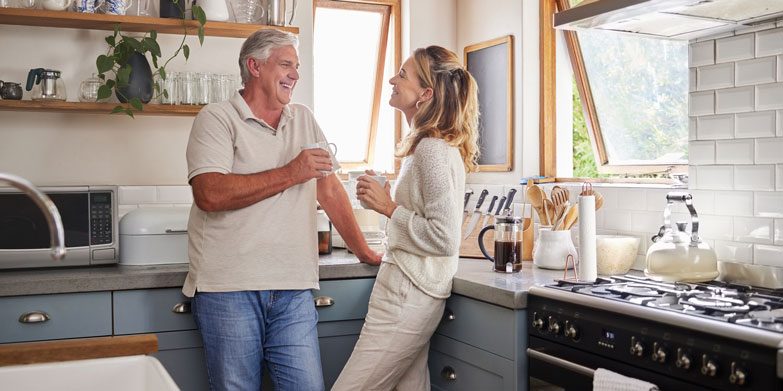Wondering when the perfect time to downsize is? Real estate guru Henny takes us into the world of downsizing, but with a twist. Imagine taking this big step in two comfortable stages with the “double downsize”. Discover why making this move sooner can be a game-changer for your health and happiness in retirement.
Over the years, we have worked with many downsizers. Some come to us on their own accord and others have been heavily encouraged by their well-meaning children to fast-track the process of finding more suitable housing. What we have noticed is a very clear pattern of downsizers in their 70s and 80s leaving it much too late, which makes it much harder both physically and emotionally to make that big leap in one go.
This has introduced the concept of “double downsizing”.
“Double Downsizing”
More and more down-sizers are choosing the “double downsize”. This means they move in two stages instead of one. Often the first downsize is at retirement or when the youngest child is finishing High School. The second stage of downsizing happens when mobility becomes an issue and different considerations need to be prioritised (such as having lift access or living somewhere without a car).
The first stage of downsizing

On the North Shore, Double Downsizers typically start the move by going from a larger family house (often two stories or with a swimming pool that is no longer being used) on a relatively big parcel of land into a smaller single-level house, a terrace, a villa, a townhouse, a Duplex or Semi.
The second stage of downsizing

The second stage of downsizing takes place anywhere from 5-15 years later when they move to an apartment with even less maintenance, or into a retirement village or residential aged care facility, depending on the state of their health and how much help they need day-to-day.
There tends to be a stigma attached to nursing homes and this is probably why so many down-sizers try to delay this for as long as they can. In certain cultures, there is an expectation of filial piety and that children should look after their elderly parents and not “ship them off” to a care facility in their old age.
The merits of double downsizing
Downsizing in two stages is quite sensible, because it offers a gentler transition to a different pace and way of life. Many downsizers move from the Upper North Shore to Lower North Shore, the Inner West, the Northern Beaches or to the Inner City. Some move outside of Sydney to rural NSW.
In early retirement, people tend to still be quite active and mobile. They may pick up a new hobby, sign up for volunteer work, travel more, and are generally more mentally able to navigate the huge change that is leaving the family home. In many cases, there is still a partner/spouse to share the logistical burden of moving and finding a new place to live.
It becomes significantly harder when one partner becomes very ill or passes away, and this is where we find that many end up not moving at all, as it just seems too daunting. It is key to make this first stage of downsizing happen sooner rather than later, or else it may not happen at all!
When we have worked with elderly clients to help them downsize, we notice a huge difference between those who are downsizing in their 50s & 60s vs. those downsizing in their 70s, let alone in their 80s. The amount of emotional and physical energy required to inspect multiple properties can be overwhelming, plus older people tend to be more risk averse and resistant to change.
The logistics of decluttering and packing up decades worth of memories and personal belongings can also be highly emotional. Our experience shows that younger downsizers tend to be more resilient to the emotional roller coaster of selling and buying than older downsizers.
Divorce-led downsize
Figures released by the Australian Institute of Family Studies in March 2023 show an upward trend for 50+ age groups getting divorced in 2021. With the increased trend in “grey divorce” (a term used to describe older adults – usually aged over 50 and from long-lasting marriages who separate), we have also noticed many women in particular, forced to downsize earlier than they would like due to financial circumstances.
We have worked with many divorced women in their 40s and 50s who are in this exact predicament. Whilst they may be overwhelmed initially, we find divorced women to be extremely resilient and highly adaptable. They simply get on with it and seem to ultimately adjust fine to their change in circumstances. However, divorced women must get the right advice and professional guidance in choosing their property as they really cannot afford to make a mistake with such a huge decision.
What downsizers want from a new home

The most commonly requested features in a home by downsizers are:
- Completely level access with no stairs/steps (or else lift)
- A turnkey property (requiring no renovation)
- Wide doorways and showers (no shower-over-bath) to accommodate a walking frame and possibly a wheelchair
- Proximity to public transport and shops as many foresee not being able to drive in the coming years
- Some kind of outdoor space which is low maintenance and good storage space.
From our experience, most downsizers underestimate how long it takes to find the right type of housing. They also almost always underestimate the cost! It is a marathon and not a sprint; and important to start the process early because it can easily take more than a year, and some failed attempts, to find the right property to downsize to.
It would be helpful if the Government provided a financial incentive (such as a stamp duty exemption or discount) for people to downsize earlier. Especially as many are asset rich but cash poor. Finances aside, it is important to acknowledge that unlike the current generation of homeowners who are perhaps used to moving multiple times in their life, baby boomers and older often have lived in the same home for 30-50 years and it is not easy to let go.
The aging-process varies. For some, it will be gradual without hiccups but for others it may be more complicated and unpredictable. Therefore, planning early and ahead for each stage is key to maximising independence and quality of life, and minimising stress when decisions have to be made under duress.
No one likes to think about ageing and the physical and cognitive decline associated with old age. Therefore, sensitivity is definitely needed in having the difficult conversations about downsizing; but also, equal dose of constructive encouragement because it is a difficult journey to undertake for most.












